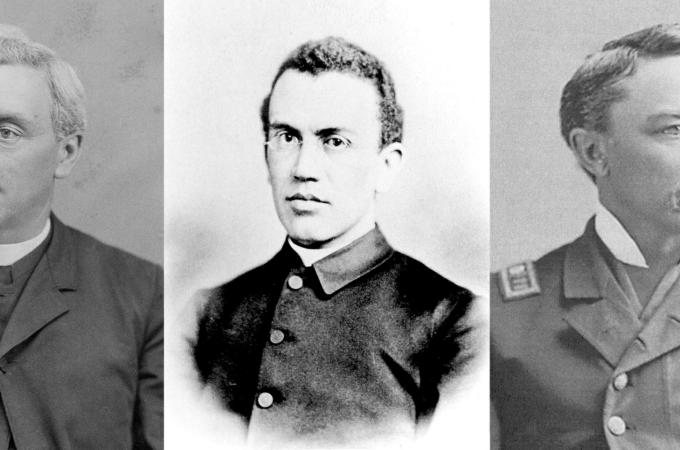The Healy sons and brothers
Marking Black History Month, we present the second installment of a three-part series exploring the life and legacy of America's first African-American bishop, Bishop James Augustine Healy, and his family.
In the chance meeting between Michael Morris Healy of Macon, Georgia, and Bishop John Fitzpatrick of Boston, the bishop spoke excitedly about a new school that had recently opened in Worcester, Massachusetts: the College of the Holy Cross. For Healy, it had immediate appeal. Enrolling his children would get them out of the South, where they would always legally be slaves, and into freedom. Once there, association with the Jesuits put several members of the family on the road to careers as Catholic priests and nuns.
In 1844, the four oldest Healy brothers -- James, Hugh, Patrick, and Sherwood, ranging in age from 14 to 8 -- traveled to Worcester to begin their studies; only Hugh would ever visit Georgia again. Though called a college, Holy Cross had a curriculum more nearly that of a middle and high school. The boys were star pupils: James ranked number one in the first graduating class in 1849. They were also popular with classmates and, despite entrenched attitudes of racial discrimination, their mixed-race origins seemed not to matter. Only Sherwood bore on his face the tell-tale signs of what Bishop Fitzpatrick called "African blood."
The religious character of the school had a decisive impact. At the end of the annual student retreat in their first year, all four were baptized as Catholics. "What a change," James later wrote in his diary, recalling the event. Before that, "I was nothing, now I am a Catholic." None of them had been baptized as children. There was no Catholic parish near their home, and a priest from South Carolina managed to visit the area only occasionally. James was not alone in feeling the power of this transformation, as he and two of his brothers resolved to become priests.
After his graduation, James was sent first to a seminary in Montreal and then one in Paris, and he was ordained there amid the splendor of Notre Dame Cathedral in 1854. Returning to Boston, he became Bishop Fitzpatrick's right-hand man, serving as the first chancellor of the diocese. These were eventful times. The original cathedral on Franklin Street was too small, and James helped secure a new location, the present site of the cathedral on Washington Street. The tensions of the Civil War added complexity, and he helped calm the city amid draft-resistance riots in 1863, a contrast to more destructive unrest in New York City. His abilities were widely recognized, and in 1875 the pope named him the second bishop of Portland, Maine. He served for a quarter-century, opening new parishes for the expanding immigrant population and bringing in new orders of sisters to staff the growing number of parochial schools. By the time of his death in 1900, he was a respected figure in the city and state, praised by civic and religious leaders.
Patrick Healy followed his brother into the priesthood, but he chose to join the Jesuits. After studies in Maryland and Louvain in Belgium, he was assigned to the faculty at Georgetown University, a school that itself had owned slaves, disposing of them in a controversial sale in the 1830s. But this was no barrier to Patrick's advancement. He was a popular teacher -- "the clearest thinker and expounder of his thoughts that I ever met," one student said -- and also served as dean before being named president of the school in 1873. His racial origins were not generally known, and his appointment was risky. If word got out that someone who society defined as black was president, the university probably could not have survived. But he reformed the curriculum and began construction of what became the main college building, a building that now bears his name. After retirement, he spent most of his time helping his brother with parish work in Maine.
Sherwood also became a priest in Boston, serving first at the House of the Angel Guardian orphanage and then as rector of the new Holy Cross Cathedral, construction of which he supervised. He liked to point out that the church's towers were 80 feet taller than the Bunker Hill Monument, a gentle jab at Yankee Boston. His success with that project led to his appointment as pastor of nearby St. James's parish, itself in the process of building a new church. But his fragile health gave out, and he died in 1875. Had he survived, he like James might well have been appointed a bishop.
The other two Healy brothers did not pursue priestly careers. Hugh, the second oldest, had set himself up in business in New York City and was making his way when he was killed in a freak boating accident at age 21. Michael ran away to sea as a teenager, and he eventually served as a captain in the U.S. Revenue Cutter Service, precursor to the modern-day Coast Guard. He may have had the most picturesque career of all, enforcing law and order in the waters off Alaska in the 1880s and 1890s.
So much accomplishment in any one group of brothers would have been remarkable, but it was all the more so for the Healys. According to the dictates of the infamous "one-drop" rule, the "African blood" of their mother was thought to make them African American too. But they ignored that rule and set out to build lives of their own. As we'll see next week, their sisters did the same.



















